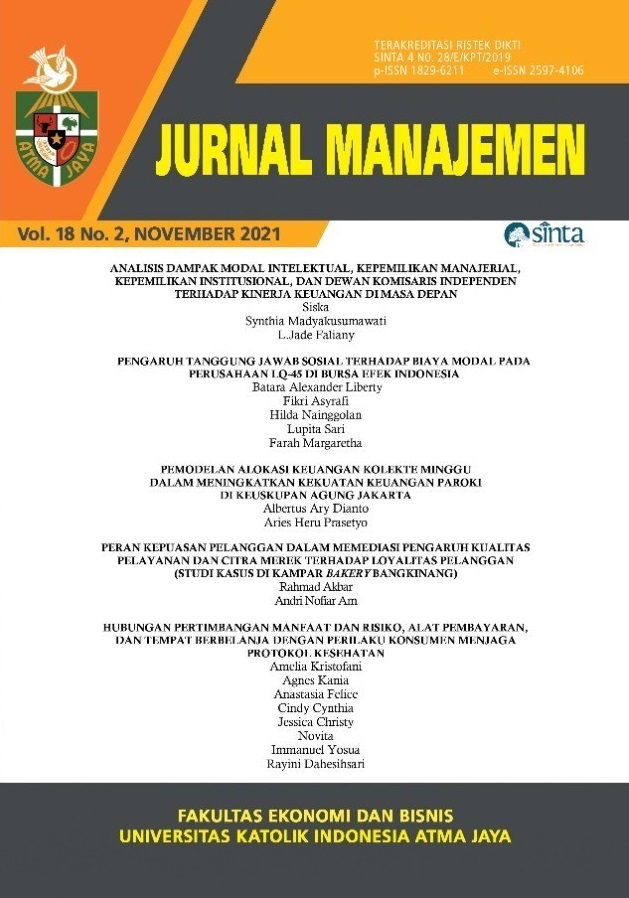PENGARUH TANGGUNG JAWAB SOSIAL TERHADAP BIAYA MODAL PADA PERUSAHAAN LQ-45 DI BURSA EFEK INDONESIA
DOI:
https://doi.org/10.25170/jm.v2i18.2680Keywords:
Corporate Social Responsibility, Cost of Debt, Cost of EquityAbstract
Corporate social responsibility (CSR) is a long-term business strategy that is contradictory to one of the company's goals, which is profit, so shareholders are faced with dilemmas and polemics, especially in Indonesia. Therefore, this study was conducted to find evidence whether CSR is able to offer value-added to shareholders by influencing the company's cost of capital which consists of cost of equity and cost of debt. The independent variable used is the cost allocated to support CSR activities. There are six control variables which are systematic risk, price to book ratio, firm size, debt ratio, revenue growth, composition of independent commissioners. The researcher uses data from 22 companies whose shares have been listed on the Indonesia Stock Exchange as LQ-45 for the period 2014-2020 and uses a multiple regression research testing model. The conclusion of this studies indicate that corporate social responsibility has a significant positive effect on the cost of equity and a significant negative effect on the cost of debt. Firm size has a negative effect on both the cost of equity and the cost of debt, while revenue growth has a positive impact on the cost of equity. The debt ratio has a positive effect on the cost of debt. The other variables do not have a significant effect on the cost of capital. This study is expected to be able to help interested parties to predict, control and anticipate the movement of the company's cost of capital'
References
Bowen, R., Chen, X, & Cheng, Q. (2008). Analyst coverage and the cost of raising equity capital: evidence from underpricing of seasoned equity offerings. Contemporary Accounting Research,Vol.25, 657-699.
Cooper, E. W., & Uzun, H. (2015). Corporate Social Responsibility and the Cost of Debt. Journal of Accounting and Finance.
Cox, P., Brammers,S, & Millington, A. (2004). Information asymmetry, the cost of debt, and credit events: evidence from quasi-random analyst disappearances. Journal of Business Ethics, Vol. 52 No. 1, 27-43.
Dai, J, Lu, C, & Qi, J. (2019). Sustainability (Switzerland), Vol. 11. Corporate Social Responsibility disclosure and stock price crash risk: Evidence from China, 448.
Ehrhardt, M. C., & Brigham, E. F. (2011). Financial Management: Theory and Practice. United States of America: South-Western Cengage Learning.
El Ghoul, S., Guedhami, O, Kwok, C.C.Y, & Mishra, D.R. (2011). Does corporate social responsibility affect the cost of Capital? Financial Management, Vol. 42 No. 2, 441-477.
Feng, Z.Y, Wang, M.L, & Huang, H.W. (2015). Equity financing and social responsibility: furtherinternational evidence. The International Journal of Accounting, Vol. 50 No. 3, 247-280.
Garcia Sanchez, I.M, & Garcia Meca, E. (2017). CSR engagement and earnings quality in banks. The moderating role of institutional factors. Corporate Social Responsibility and Environmental Management Vol. 24 no 2, 145-158.
Ge, W, & Liu, M. (2015). Corporate social responsibility and the cost of corporate bonds. Journal of Accounting and Public Policy, Vol. 34 no 6, 597-624.
Goss, A, & Roberts, G.S. (2011). The impact of corporate social responsibility on the cost of bank loans. Journal of Banking & Finance, Vol. 35 No. 7, 1794-1810.
Himme, A, & Fischer, M. (2014). Drivers of the cost of capital: the joint role of non-financial metrics. International Journal of Research in Marketing Vol. 31 No. 2, 224-238.
Hunjra, A. I., Mehmood, R, & Tayachi, T. (2020). How Do Corporate Social Responsibility and Corporate Governance Affect Stock Price Crash Risk? Journal of Risk and Financial Management, Vol. 13.
Ifonie, & Regina Reizky. (2012). Pengaruh Asimetri Informasi Dan Manajemen Laba terhadap Cost Of Equity Capital Pada perusahaan Real Estate Yang Terdaftar Di Bursa Efek Indonesia. Jurnal Ilmiah Mahasiswa Akuntansi. Vol 1.
Kazemi, H., & Rahmani, F. (2013). Relationship between information asymmetry and cost of capital. Management Science Letters, Vol. 3 no 1, 321-328.
Martı´nez-Ferrero, Ruiz-Cano, & Garcı´a-Sa´nchez. (2016). The causal link between sustainable disclosure and information asymmetry: the moderating role of the stakeholder protection context. Corporate Social Responsibility & Environmental Management, Vol. 23 No. 5.
Md. Borhan Uddin Bhuiyan, & Thi Hong Nhung Nguyen. (2020). Impact of CSR on cost of debt and cost of capital: Australian evidence. Social Responsibility Journal Vol. 16 No. 3 , 419-430,.
Perez, A. (2015). Corporate reputation and CSR reporting to stakeholders: gaps in the literature. Corporate Communications: An International Journal, Vol. 20.
Servaes, H., & Tamayo, A. (2013). The Impact of Corporate Social Responsibility on Firm Value: The Role of Customer Awareness. Management Science,1045-1061.
Wheelen, T. L., J. David Hunger , Alan N. Hoffman, & Charles E. Bamford. (2018). Strategic Management and Business Policy Globalization, Innovation and Sustainability. United Kingdom: Pearson Education Limited.
Downloads
Published
Issue
Section
License
Authors who publish with this journal agree to the following terms:
Authors retain copyright and grant the journal right of first publication with the work simultaneously licensed under a Creative Commons Attribution-NonCommercial-ShareAlike License that allows others to share the work with an acknowledgement of the work's authorship and initial publication in this journal.
Authors are able to enter into separate, additional contractual arrangements for the non-exclusive distribution of the journal's published version of the work (e.g., post it to an institutional repository or publish it in a book), with an acknowledgement of its initial publication in this journal.
Authors are permitted and encouraged to post their work online (e.g., in institutional repositories or on their website) prior to and during the submission process, as it can lead to productive exchanges, as well as earlier and greater citation of published work (See the Effect of Open Access).











